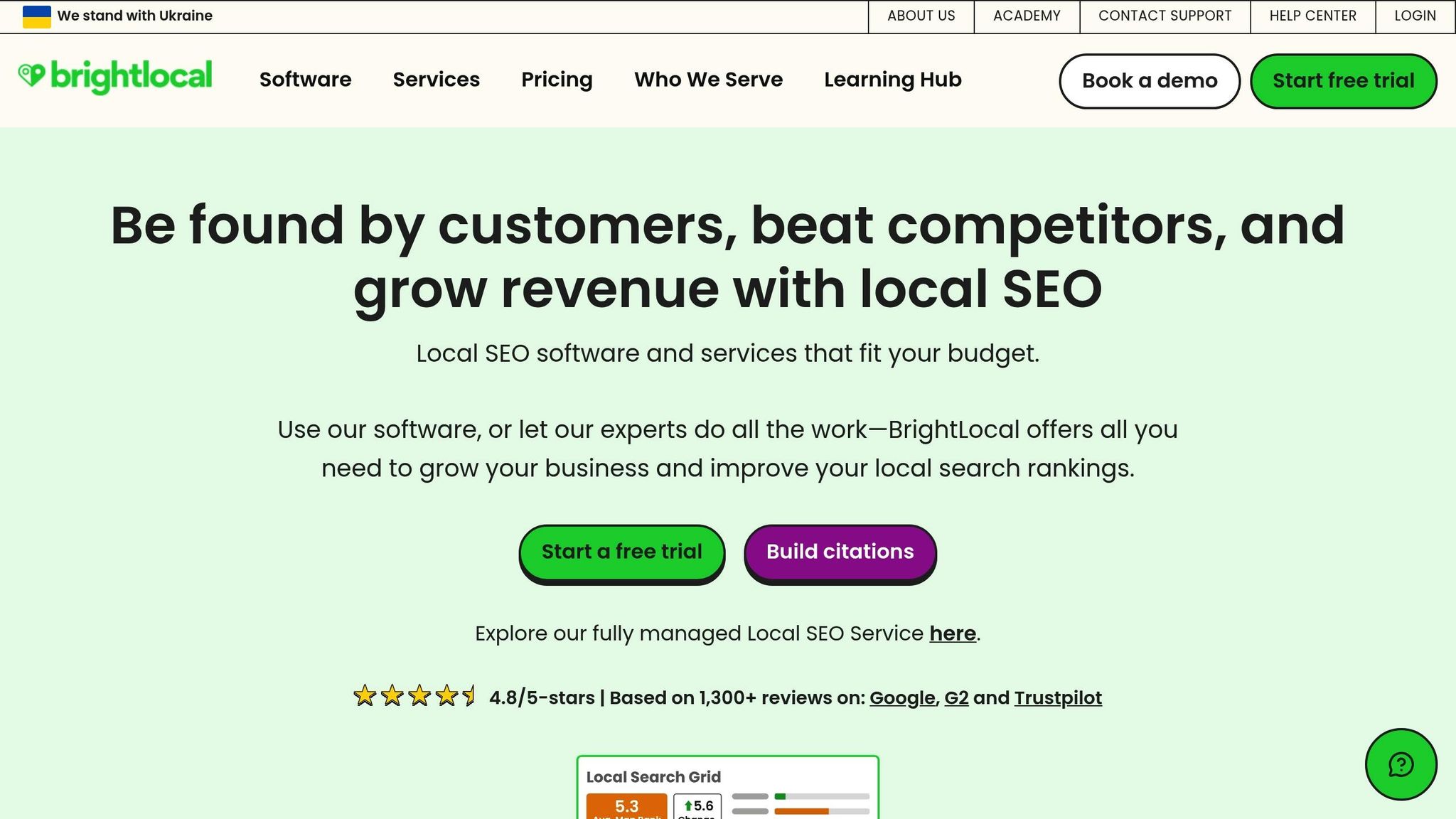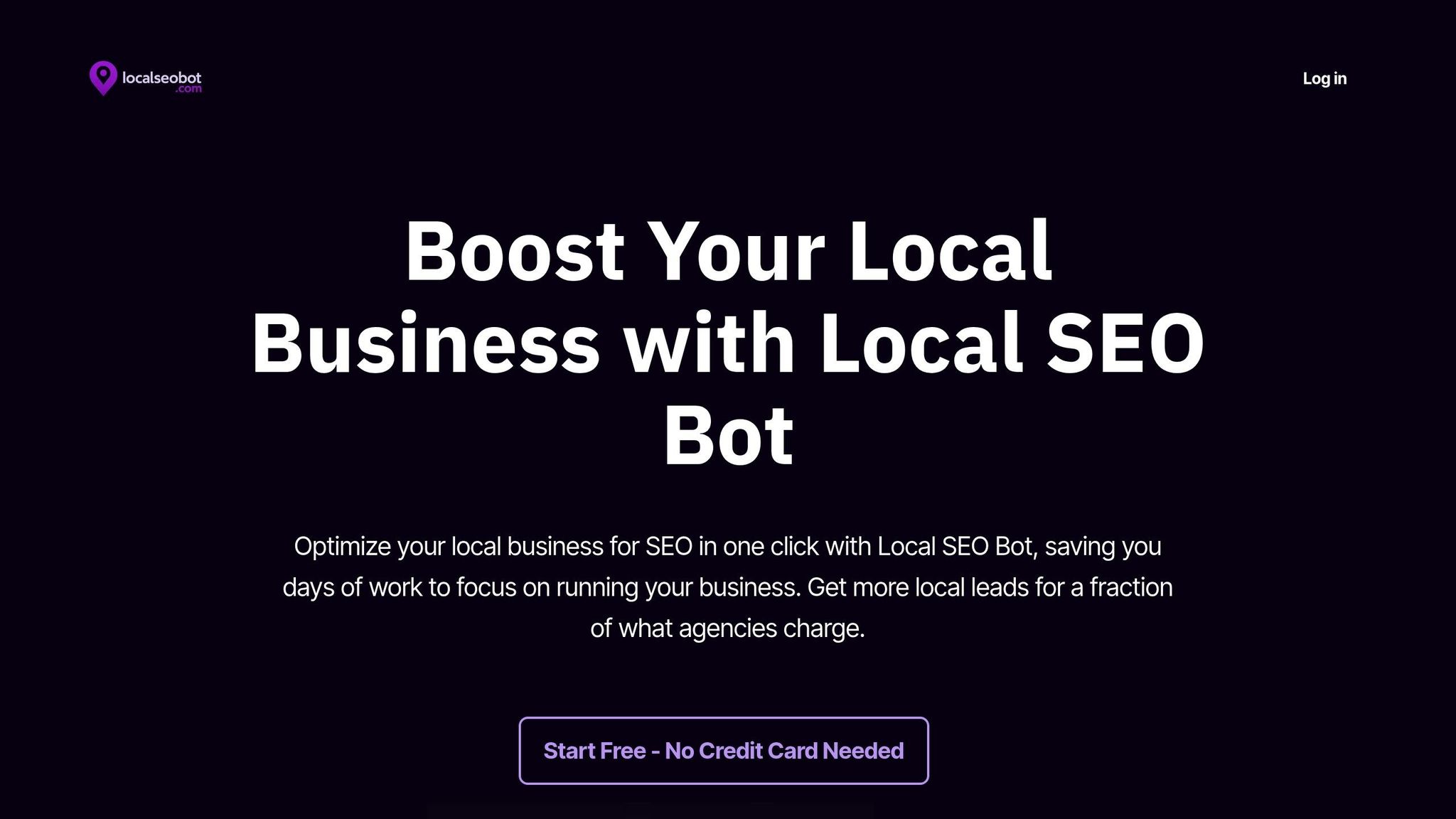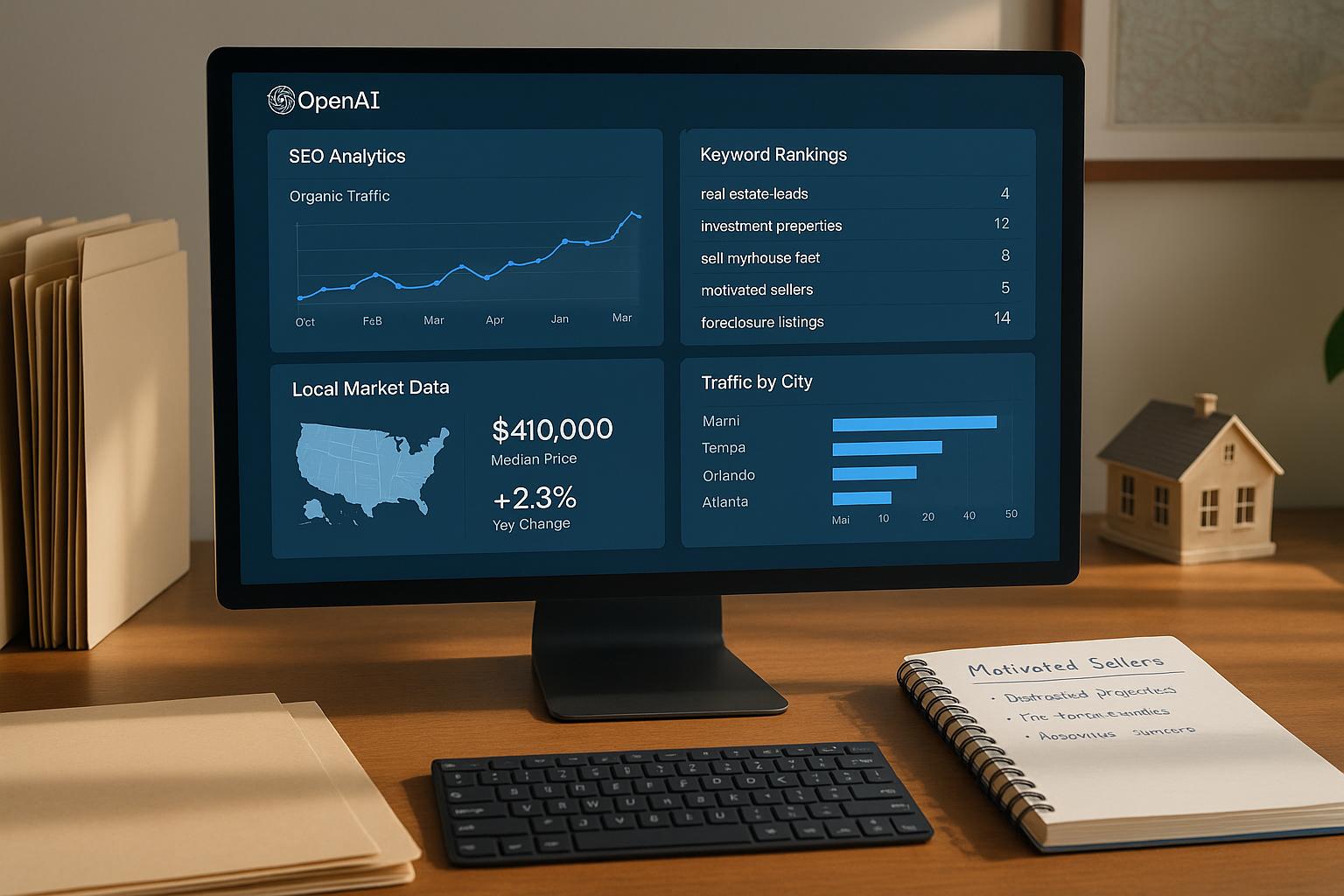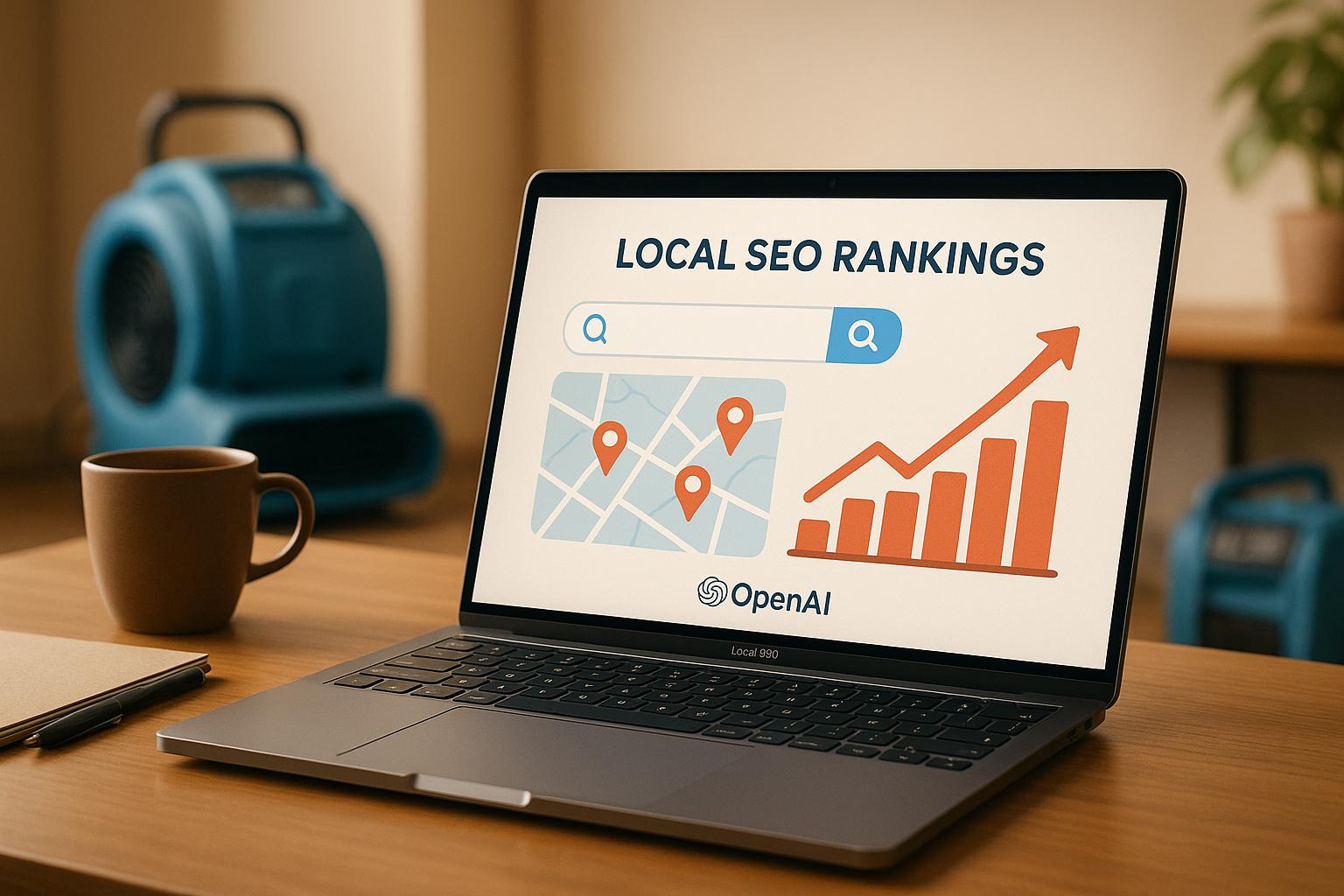Local competitor analysis helps you understand how nearby businesses attract customers and perform in local search results. By studying their strategies, you can improve your visibility, identify market gaps, and gain an edge in your area. This guide covers key aspects of competitor analysis, including tools like Local SEO Bot, which automates tasks like tracking rankings, managing reviews, and auditing local SEO efforts.
Key Takeaways:
- Why it matters: Most customers rely on online searches to find local services. Analyzing competitors helps you improve your visibility and attract more customers.
- Main goals: Identify competitors’ strengths/weaknesses, find market gaps, benchmark your performance, and refine your strategies.
- Tools to use: Platforms like Local SEO Bot automate data collection, monitor rankings, and provide actionable insights to simplify competitor analysis.
Quick Overview:
- Identify competitors: Use Google Maps, local searches, and directories like Yelp to find direct, indirect, and replacement competitors.
- Track key metrics: Rankings, reviews, citation accuracy, and keyword strategies are crucial for success.
- Automate tasks: Tools like Local SEO Bot save time by automating audits, review management, and monitoring.
By leveraging the right tools and strategies, you can stay ahead of competitors and grow your local presence effectively.
Performing Local Competitor Analysis with BrightLocal | BrightLocal Bootcamp 3

Main Parts of Local Competitor Analysis
Local competitor analysis helps you pinpoint other players in the market, giving you actionable insights to refine your local SEO strategies and stand out.
Finding Your Local Competitors
The first step is identifying competitors - not just those offering the exact same services, but also others vying for the attention of your target audience.
Direct competitors are the easiest to spot. These are businesses offering the same products or services as you. For example, if you own a dental clinic, other dental offices in your area are direct competitors. Similarly, if you run a pizza restaurant, nearby pizzerias fall into this category.
Indirect competitors target the same customer base but meet their needs differently. For instance, a coffee shop might see a local bakery as an indirect competitor because both cater to people looking for a quick morning snack or a casual meetup spot.
Replacement competitors provide alternatives that could completely replace your service, even if they come from a different industry. For example, an escape room business may view streaming services as replacement competitors since both compete for customers' entertainment budgets and time.
"By considering all these types of competitors, you'll gain a more complete understanding of your competitive landscape and be better prepared to position your business effectively." – Chatmeter Team
Start your research using Google Maps and local searches. Enter keywords related to your business along with your city name into Google, and check both the map results and organic listings. You can also search directly in Google Maps by your business category to identify competitors near you.
Local directories like Yelp, Yellow Pages, or industry-specific platforms are also useful. These directories often allow you to filter by location and category, making it easier to uncover businesses you might have missed.
Community insights can be invaluable too. Attend local chamber of commerce meetings, trade shows, or networking events to discover competitors who may not have a strong online presence. You can also ask your customers which alternatives they considered before choosing your business.
To keep things manageable, focus on the top 3–5 direct competitors initially. Use a spreadsheet to organize your findings, categorizing competitors by type, location, services, and online presence.
Once you have a solid list of competitors, you can start tracking their rankings and analyzing their reviews to gain a deeper understanding of the market.
Important Features in Local Competitor Analysis Tools
When picking tools for local competitor analysis, the right features can save you from drowning in spreadsheets and endless manual research. They streamline the process, offering small business owners a way to stay competitive without wasting precious time.
Automated Data Collection and Updates
Manual tracking is a time sink - and it’s prone to errors. Automated data collection takes the burden off your shoulders by continuously gathering information from competitor websites, Google Business Profiles, and review platforms. Instead of manually checking these sources, automated tools do the legwork for you.
The best tools refresh data in real time, keeping you updated on competitor ranking changes in Google Maps. Local search rankings can shift daily due to factors like new reviews, updates to business details, or algorithm changes. Automated tracking ensures these fluctuations are captured as they happen, giving you a complete and accurate view of the competitive landscape.
Another advantage? Fewer mistakes. Manually transferring data into spreadsheets often leads to errors or missed details. Automated tools pull data directly from the source, ensuring accuracy and consistency. This real-time accuracy keeps you on top of market changes, so you’re always informed.
Real-Time Monitoring and Reporting
Real-time monitoring ensures you’re not working with outdated information. It keeps you in the loop about competitor activities as they happen, allowing you to respond quickly to new opportunities or threats.
For instance, if a competitor drops in Google Maps rankings, real-time alerts let you investigate immediately. You might discover they’ve received negative reviews, have inconsistent citations, or made changes to their Google Business Profile that hurt their visibility. This insight not only helps you avoid similar mistakes but also creates opportunities to improve your own positioning.
Comprehensive reporting is another vital feature. It transforms raw data into clear, actionable insights. Instead of wading through endless metrics, good tools provide dashboards that highlight the trends and changes that matter most. This saves time and ensures you’re focusing on what’s important.
Historical data comparison is also key. Being able to track how competitor rankings, reviews, and online presence evolve over time helps you identify patterns and anticipate future trends. This context allows you to make smarter decisions for your local SEO strategy. Clear reporting and immediate alerts work together to turn data into actionable insights, driving better strategic planning.
Clear Insights and Recommendations
Raw data alone doesn’t help - it’s the insights and recommendations that make the difference. The best competitor analysis tools go beyond collecting information; they interpret the data and suggest specific actions. This is especially helpful for small business owners who may not have deep SEO expertise.
For example, if competitors consistently outrank you for certain keywords, the tool should recommend which keywords to target and how to optimize your content. If competitors have stronger review strategies, it should provide actionable tips to improve your review management.
Prioritized recommendations are a game-changer. Instead of overwhelming you with a long list of potential improvements, these tools rank suggestions by their impact on your local search visibility. This way, you can focus on the changes that will deliver the biggest results first.
Local SEO Bot, for example, uses these insights to offer one-click optimizations that address performance gaps directly. By combining detailed competitor analysis with easy-to-implement solutions, it simplifies the process for small business owners looking to boost their local presence.
When automated data collection, real-time monitoring, and actionable recommendations come together, they create a solid foundation for effective competitor analysis. These features save you time, keep you informed, and guide your decisions to improve your local search performance.
How Local SEO Bot Makes Local Competitor Analysis Easy

Local SEO Bot simplifies competitor analysis by offering an all-in-one, automated solution that saves time and delivers actionable insights. Instead of juggling multiple tools, this platform combines everything you need in one place, making it user-friendly - even for those without a technical background. By building on features like automated data collection and real-time monitoring, it provides a streamlined way to enhance your local SEO efforts immediately.
One-Click Optimization
The one-click optimization feature takes the hassle out of manual updates. Forget spending hours updating business listings across directories - Local SEO Bot handles it instantly, ensuring your information stays consistent everywhere. This is especially handy when competitors have more complete or accurate listings.
It also includes automated ranking tracking, allowing you to see your Google Maps position at a glance and adjust your strategy quickly.
On top of that, the platform simplifies review management by automating review requests and responses. For instance, if a nearby competitor starts gaining more glowing reviews, Local SEO Bot can send out additional review requests to help you stay competitive and maintain a strong reputation.
Complete Dashboard
The platform’s centralized dashboard brings all your metrics together, making it easy to make informed decisions. With side-by-side comparisons of your business and competitors on Google Maps, you can track review volumes, sentiment changes, and the results of your optimization efforts - all in one place.
The dashboard offers real-time metrics like local search rankings, review scores, citation consistency, and audit results. These are presented in formats familiar to US business owners: rankings as clear position numbers, reviews on a 5-star scale, monetary figures in US dollars ($), and dates in MM/DD/YYYY format. This clarity makes it simple to track progress and identify areas for improvement.
Visual indicators highlight performance gaps, such as differences in review volume or ranking positions, so you can quickly spot opportunities. Historical data comparisons reveal trends over time, helping you understand competitor behavior and strategically plan your next moves.
Automated Review Management and Local SEO Audits
With automated review monitoring, Local SEO Bot consolidates reviews from platforms like Google, Yelp, and Facebook. It even provides sentiment analysis, flagging trends in competitor feedback - like recurring complaints or praise - that might impact their rankings. For example, if competitors often get complaints about parking, you can highlight your convenient parking as a selling point.
The platform also conducts regular local SEO audits, automatically checking for issues like inconsistent citations, incomplete business details, or poor keyword usage. These audits compare your performance against competitors, pinpointing specific areas where they excel, such as being listed in more directories or using better-targeted keywords. This takes the guesswork out of optimization, giving you a clear path to improvement.
sbb-itb-0e6533f
Best Practices for Local Competitor Analysis
To get the most out of your competitor analysis, you need a well-thought-out approach that balances efficiency with effectiveness. By adopting consistent habits and focusing on key areas, you can transform competitor insights into actionable strategies that improve your local search visibility.
Set Regular Monitoring Routines
Consistency is key when it comes to competitor analysis. Start by establishing a weekly routine - Tuesday mornings work well - to check rankings, reviews, and listing updates. This keeps you in the loop and allows you to react swiftly to any changes in the competitive landscape.
Take a deeper dive once a month to uncover broader patterns like seasonal trends, shifts in customer sentiment, or changes in services offered by competitors. This helps you stay ahead of market changes and adjust your strategy accordingly.
Pay attention to key events that could influence local search results. For example, if a competitor starts sponsoring local events or participating in community activities, observe how this impacts their visibility. These activities might signal opportunities for your business to engage with the community in similar ways.
Alerts can also be a game-changer. Set up notifications for significant competitor moves, like gaining or losing a large number of reviews, updating business hours, or changing service descriptions. Understanding the reasons behind these changes can help you spot opportunities or address potential threats.
By sticking to a structured monitoring plan, you’ll focus your efforts where they matter most.
Focus on High-Impact Areas
Not all aspects of competitor analysis yield the same results, so it’s crucial to zero in on the areas that directly influence your local rankings. Review management, citation accuracy, and keyword optimization should be at the top of your list.
Reviews are a major factor in rankings and customer decisions. Study how competitors generate positive reviews and manage negative ones. This can provide valuable insights to refine your own approach.
Citation consistency is another easy win. If competitors have outdated or incomplete information in directories, it’s an opportunity for you to stand out by maintaining accurate and thorough listings. Give extra attention to trusted platforms like Yelp, Better Business Bureau, and niche-specific directories.
Look at how competitors use keywords in their business descriptions. Many miss the chance to include location-specific terms or service-related keywords. By identifying these gaps, you can improve your own listings and gain an edge in local search results.
Geographic coverage matters too. If competitors focus heavily on certain neighborhoods while neglecting others, consider targeting those underserved areas. Adjusting your service area or tailoring your SEO strategy for those locations could help you capture untapped demand.
Finally, analyze service gaps. Competitor reviews and social media interactions can reveal unmet customer needs. If you notice recurring requests for services they don’t offer, consider whether adding those services aligns with your business goals.
By prioritizing these areas, you can strengthen your local presence and outperform competitors where it counts.
Use Automation for Efficiency
Manually tracking competitors can be overwhelming, but automation tools make it manageable. Tools like Local SEO Bot take care of repetitive tasks, allowing you to focus on strategy and execution.
Set up automated alerts for major competitor changes. For example, if a competitor’s rating drops below 4.0 stars, gains a surge of reviews, or updates their business info, you’ll get notified immediately. This real-time awareness lets you act quickly - whether it’s seizing an opportunity or addressing a new challenge.
Automated citation monitoring ensures your business information remains consistent across directories while tracking competitor listings. This eliminates the hassle of manually checking each platform.
Review monitoring tools can also save time and provide deeper insights. Sentiment analysis, for instance, can highlight recurring themes in competitor reviews, giving you a clearer picture of their strengths and weaknesses.
Monthly automated reports are another valuable resource. These reports track trends in rankings, review growth, and citation accuracy, helping you measure your progress and refine your strategy over time.
The time saved through automation isn’t just a convenience - it’s an opportunity. Use that extra time to focus on customer service, develop new offerings, or enhance your online presence. Let the tools handle the data while you concentrate on what sets your business apart.
Tables for Effective Comparison
Tables are a great way to organize competitor data into clear, actionable insights. Instead of juggling multiple spreadsheets, a well-designed table brings all the critical information into one place, making it easier to spot trends and opportunities at a glance.
The trick lies in structuring your data for effortless comparison. For example, placing your Google Maps ranking alongside competitors in the same row allows you to quickly assess where you stand and make informed decisions faster.
Sample Table for Competitor Analysis
When creating a competitor analysis table, focus on metrics that directly impact local search performance. Metrics like Google Maps ranking show visibility, review count and average rating reflect reputation, and citation score indicates listing consistency across the web. These metrics are the foundation of local SEO success.
Here’s an example:
| Competitor Name | Google Maps Ranking | Review Count | Average Rating | Citation Score | Website Traffic | Social Media Engagement |
|---|---|---|---|---|---|---|
| Your Business | 4 | 127 | 4.6 | 85% | 2,500/month | 450 followers |
| Main Street Bakery | 2 | 203 | 4.4 | 92% | 3,200/month | 680 followers |
| Corner Café | 6 | 89 | 4.8 | 78% | 1,800/month | 320 followers |
| Downtown Deli | 3 | 156 | 4.2 | 88% | 2,100/month | 520 followers |
This format makes insights immediately clear. For instance, while Main Street Bakery leads in rankings and citation consistency, your business has a higher average rating. Corner Café shows excellent customer satisfaction despite lower visibility. These insights can guide you in deciding where to focus your efforts.
Tools like Local SEO Bot can automate updates to these tables, ensuring your data stays current. Aim to refresh your tables monthly, though in fast-changing markets, weekly updates may be more effective. Set alerts for major changes, such as a significant drop in ratings, a spike in review counts, or new competitors entering the scene.
Once you’ve established this baseline, extend your analysis over time to track your progress.
Tracking Progress Over Time
Time-series tables are a powerful way to monitor whether your strategies are working and to spot emerging trends.
Set up monthly tracking tables to capture changes in key metrics over time. By using columns for each month and rows for each metric, you can easily visualize trends - whether they’re moving up, down, or staying flat. This approach helps you identify which strategies are working and where adjustments might be needed.
Here’s an example of a progress tracking table:
| Metric | Jan 2024 | Feb 2024 | Mar 2024 | Apr 2024 | Trend |
|---|---|---|---|---|---|
| Google Maps Ranking | 6 | 5 | 4 | 3 | ↗️ Improving |
| Review Count | 89 | 97 | 112 | 127 | ↗️ Growing |
| Average Rating | 4.3 | 4.4 | 4.5 | 4.6 | ↗️ Rising |
| Citation Score | 72% | 78% | 82% | 85% | ↗️ Strengthening |
This format makes your progress easy to see. For instance, improving review counts and citation scores might coincide with better Google Maps rankings. Tools like Local SEO Bot can simplify this process by offering unified dashboards with one-click reports and alerts for significant changes, saving you time and helping you make faster decisions.
You can also use this time-series approach to compare your progress against competitors. If a competitor's ranking suddenly improves while yours remains steady, dig deeper to figure out what changed. Maybe they launched a review campaign or updated their business details. Spotting these shifts early allows you to adapt your strategy quickly.
Additionally, keep an eye on your Share of Local Voice (SoLV), which measures how often you appear in the Top 3 positions or the Google Map Pack. A table that tracks monthly SoLV for your business and competitors can reveal changes in market share over time.
Conclusion
Analyzing local competitors sheds light on your market position and reveals opportunities to grow, helping you make smarter marketing decisions and improve customer satisfaction.
Competitor analysis tables can uncover trends - like sudden jumps in Google Maps rankings or an increase in review counts - that hint at strategic moves you can either adopt or counter. These insights allow you to allocate resources wisely and avoid wasting time on ineffective tactics in your local market.
Main Takeaways
Here are three key insights to keep in mind:
- Automation turns competitor analysis into a strategic advantage. Manually tracking competitors is time-intensive. Tools like Local SEO Bot simplify this process by automating data collection and optimization, freeing you to focus on your customers and business growth.
- Consistent monitoring outperforms occasional deep dives. Regular monthly competitor analysis helps you track market trends and identify opportunities early. Monitoring metrics like Google Maps rankings, review counts, and citation scores over time provides a clearer view of what works and what doesn’t.
- Structured data simplifies decision-making. Organized competitor tables make it easier to spot strengths and weaknesses, whether you're tracking performance metrics or analyzing review strategies.
Next Steps for Small Business Owners
Start by conducting a baseline competitor analysis this week. Identify your top three local competitors and collect key data points like their Google Maps rankings, review counts, average ratings, and citation scores. This snapshot will serve as a foundation for tracking progress over time.
Once you’ve gathered your data, streamline your process with automation. Use tools like Local SEO Bot to set up monthly monitoring routines. Its unified dashboard eliminates the need to manually check multiple sources, while features like automated review management and local SEO audits keep your business competitive. At just $49 per month for the Basic plan, you’ll save time while staying on top of your local SEO efforts.
Focus on high-impact areas to gain an edge over competitors. For example, if a competitor has 200+ reviews and you only have 50, prioritize growing your review count before worrying about matching their citation score. Local SEO Bot’s automated review response features can help you maintain customer engagement as you build momentum.
Markets are always shifting - new competitors appear, and customer preferences change. By monitoring regularly and using automation tools, you’ll stay ahead of the curve and continue attracting more local customers to your business.
FAQs
How can I find indirect and alternative competitors in my local market?
To spot indirect competitors (those offering substitute products or services) and alternative competitors (businesses addressing similar customer needs in different ways) in your local market, focus on identifying businesses that cater to a similar audience but provide different solutions. Here's how you can approach this:
- Dive into customer reviews and feedback: Pay attention to where customers mention shopping or comparing alternatives. This can give you insights into other businesses they consider.
- Explore local directories and Google Maps: These tools can help you pinpoint businesses with overlapping customer bases in your area.
- Leverage tools like Google Trends: Use these to track industry trends and uncover potential substitutes that might not be immediately obvious.
By understanding these competitors, you can gain a clearer picture of the competitive landscape and discover ways to stand out.
What features should a local competitor analysis tool have to effectively track and report on competitors?
When choosing a local competitor analysis tool, it's important to find one that offers detailed data tracking to keep an eye on how competitors are performing across various platforms. The tool should also provide in-depth reporting features to spot trends and turn them into practical strategies. Finally, easy integration options are a must to ensure your workflow stays smooth and efficient.
Some standout features to prioritize include tools for benchmarking performance, monitoring local rankings, and evaluating reviews and citations. These tools are especially helpful for small businesses looking to refine their local SEO efforts, manage their Google Business Profile more effectively, and outpace competitors. The best solutions will simplify your tasks while delivering clear insights that boost visibility and bring in more customers.
How does automation make local competitor analysis more efficient?
Automation takes the hassle out of local competitor analysis by managing tedious tasks such as tracking competitor rankings, keeping an eye on reviews, and examining business profiles. This not only saves time but also minimizes the need for manual work, freeing you up to concentrate on crafting strategies rather than gathering data.
With these processes on autopilot, small businesses can spot trends faster, adapt to market shifts, and discover fresh opportunities. It’s a smart way to stay ahead of the competition while boosting efficiency and making better decisions.


